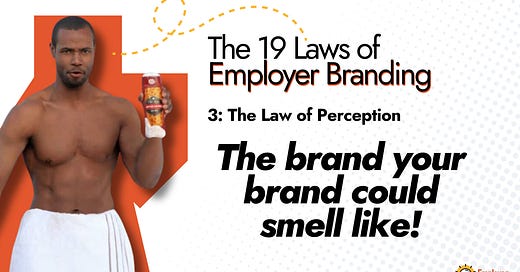Check out Monday’s edition to see the explanation of this law.
Why this works
As we talked about in the Law of Focus, brands were ways to indicate who made something because we became more and more disconnected from the maker of the thing. They started as a kind of reputation mark, a way of indicating that someone who made your last great shirt made this shirt, too.
But what makes a great shirt? Or horseshoe? Or bag of flour? Quality is completely subjective. What makes a great shirt to one isn’t important to someone else. Thus, the brand extends beyond reputation and into perception.
Where this falls apart
No less an “authority” than the American Marketing Association defines a brand in terms of its physical and visual assets. Your logo, your colors, your imagery, your fonts, your style, etc. Sorry, but that isn’t a brand. Some might refer to it as “branding” but it is a visual identity, not a brand.
For example, Nike’s swoosh is likely one of the world’s best-known logos. And when some people see it, they think of athleticism, physical achievement, and the glory of winning. And when others see it, they see an over-priced, over-marketed set of shoes. Same logo, but very different brand perspectives.
I bring this up because many people who don’t really “do” branding make this false equivalency all the time. They assume an employer brand is your style of writing more than the choice of what to write about. They think the hashtag counts for more than the content it gets attached to. They might make a variation of the logo for you, but ignore what that logo is now supposed to stand for.
Don’t fall into this trap. The brand exists in a stranger’s mind, a place you can’t touch directly.
Examples
There was a time when Old Spice was the aftershave your granddad wore. It was a brand signifying a kind of old-school rugged man, possibly a fisherman, who slapped some one to try and get rid of the aroma of yesterday’s catch of the day.
Today, Old Spice has roughly the same logo, color scheme and typography as its sea-faring ancestor, but it isn’t old school anymore. Whether it’s the now classic “the man your man could smell like” campaign or the current “smelf-confidence” ads, this is a brand for far younger men. Without changing much of the core brand identity, the company has changed what the brand stands for and how you likely think about it.
How? By changing everything around the brand. The commercials. The scents. The target audience. The product selection (Old Spice makes way more from deodorants and soaps than it does from aftershave). The language around the product family. They changed people’s perceptions by surrounding them with changed information and values.
++++
Reminder, my next $25 webinar, where content maven Rachel Kennedy and I build a July calendar right in front of you, is filling up. Register today!
***This Newsletter Contains No ChatGPT***
-James Ellis [LinkedIn] [Website]
###






Image is what you project. Brand is how it’s received.
Old Spice is a great example of a company that changed what it projected and people developed a new brand in their minds.